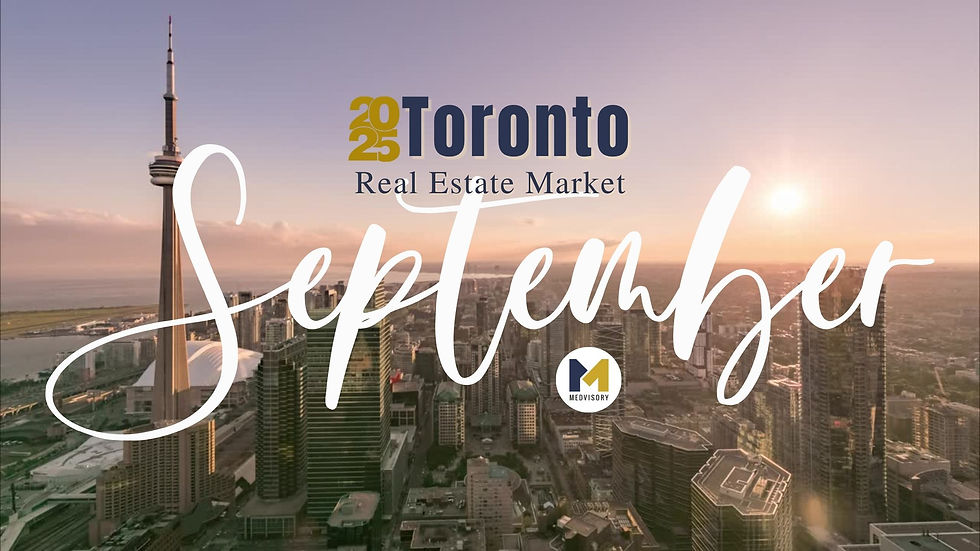Beyond the Down Payment: The True Cost of Buying a Home in Ontario
- Medvisory Team

- May 29
- 4 min read
For many first-time homebuyers in Ontario, the biggest milestone is saving for a down payment. But while that’s a major step toward homeownership, it’s far from the only cost you need to prepare for. From legal fees and land transfer taxes to hidden adjustments and closing costs, the true cost of buying a home can catch even the most prepared buyer off guard.

In this article, we break down the key expenses you should expect—both one-time and ongoing—so you can answer the question: Can I really afford that home?
1. Closing Costs: More Than Just Paperwork
Closing day isn’t just about getting the keys—it’s when many of the biggest costs hit your bank account. Here are some of the most common (and overlooked) expenses:
Legal and Notarial Fees: These cover the cost of registering your purchase and mortgage with the provincial land registry. Expect to pay between $500–$1,500 plus HST.
Disbursements and Adjustments: Your lawyer will also charge for out-of-pocket costs like title searches, courier fees, and government registration charges. Don’t forget adjustments for prepaid utilities or property taxes—amounts the seller paid in advance that you'll need to reimburse.
Land Transfer Tax (LTT): Ontario charges a one-time LTT based on your home’s purchase price. If you’re buying in Toronto, brace for an additional municipal LTT. First-time buyers may qualify for a partial rebate, but many still end up paying thousands.
Title Insurance: While optional, it’s widely recommended. For a $500,000 home, expect to pay around $300–$400. It protects against title defects, fraud, and legal costs if ownership is challenged.
Home Inspection Fee: Typically $300–$500, a home inspection can save you from unexpected surprises post-purchase.
Appraisal Fee: Some lenders require an independent property appraisal to confirm its value. This can cost $300–$500.
Mortgage Default Insurance (CMHC Insurance): If your down payment is under 20%, you’ll pay this mandatory insurance premium. It’s usually rolled into your mortgage—but the Provincial Sales Tax (PST) portion must be paid in cash at closing.
Estoppel Certificate (for Condos): This document confirms the legal and financial standing of the condo corporation. Cost: roughly $100–$200.
Interest Adjustment Costs: If your mortgage begins before your first scheduled payment, you may owe an interest adjustment up front. Check with your lender to understand how it’s calculated.
Certificate of Location or Survey: Needed to confirm the boundaries and improvements of the property. If outdated, you’ll need to pay for a new one—costs vary widely.
Upgrades (For New Builds): Granite countertops, hardwood flooring, or higher ceilings? These often cost extra—and may or may not be included in your financing.
2. Beyond Closing Day: Ongoing Monthly and Annual Costs
Owning a home comes with regular expenses that go far beyond the mortgage payment. It’s important to factor in:
Property Taxes: Based on your property’s assessed value and your municipality’s tax rate. These can vary widely—ask your agent or lawyer for an estimate before you buy.
Home Insurance: Required by lenders and critical for protecting your investment. Monthly premiums depend on location, home type, and coverage levels.
Utilities: Gas, electricity, water, and waste collection are recurring costs. Be sure to factor in seasonal changes, especially if you’re moving into a larger or detached home.
Maintenance & Repairs: From lawn care to furnace tune-ups to fixing that inevitable leaky faucet, set aside a maintenance fund. A good rule of thumb? 1% of your home’s value annually.
Other Monthly Bills: Internet, cable, phone—and don’t forget condo fees if applicable.
3. The Costs of Moving and Making a House a Home
Some costs don’t show up on a closing statement, but they still impact your bottom line:
Furniture and Appliances: Will your current couch fit in your new place? Will you need a washer/dryer? Budget for gaps.
Window Coverings and Lighting: Often not included with the sale.
Moving Costs: Whether you’re renting a truck or hiring movers, set aside $1,000–$2,000 depending on distance and volume.
Small Tools and Equipment: Lawnmowers, shovels, hoses—items first-time buyers often forget.
4. Budgeting for the Unexpected
Even if you plan meticulously, homeownership comes with surprises:
Emergency Repairs: A burst pipe, broken water heater, or roof leak can cost thousands. An emergency fund (ideally 3–6 months of living expenses) is essential.
Life Changes: A new job, a baby on the way, or a temporary income drop can change your financial landscape quickly. Plan with flexibility in mind.
5. Affordability Ratios: What Lenders Look At
Before issuing a mortgage, lenders assess your ability to repay using two standard calculations:
Gross Debt Service (GDS) Ratio: Ideally, no more than 30%–32% of your gross income should go toward housing costs (mortgage, property tax, utilities).
Total Debt Service (TDS) Ratio: This includes all debt obligations—credit cards, car loans, student debt—and should stay under 37%–40% of your gross income.
Even if you qualify for a mortgage, that doesn’t mean you can comfortably afford the property. Use these ratios as guardrails, not goals.
Buying a Home Starts with Awareness
Many homebuyers focus only on their down payment and monthly mortgage amount—but the true cost of homeownership goes far deeper. Between closing costs, monthly expenses, ongoing maintenance, and the occasional curveball, the financial commitment is significant.
The more informed you are before making an offer, the more confident you’ll be when it’s time to move in. Buying a home isn’t just about unlocking the front door—it’s about understanding the full scope of costs, responsibilities, and long-term planning that follow.



